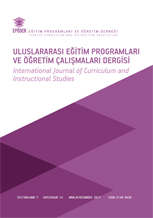A Cluster Analysis for Teachers’ Designer Role: Three Profiles with Differing Focuses on Design
Abstract
Teachers have a vital role in students’ learning. This role is multifaceted in terms of their design skills and must be unpacked to clearly understand how teachers’ daily routines differ with respect to instructional perspectives. This study introduces a comprehensive professional development (PD) program for teachers to build capacity in designing instruction and other design-related skill sets. Employing a person-centered methodology, the study aimed to identify different profiles of teachers in terms of their skills in designing instruction, implementing lessons, updating professional knowledge, digital learning systems, and facilitation/leadership. Through the application of cluster analysis on a cohort of 130 educators, three distinct designer teacher profiles emerged: high-designers (n = 29), mid-designers (n = 64), and low-designers (n = 37). These profiles delineate both shared attributes and discrepancies. In addition, the study delved into the variances within these profiles concerning teachers’ grasp of curriculum development and self-reported utilization of innovative pedagogical methods. Means analysis further shows that as the profile gets higher, the curriculum development knowledge and the use of teaching and learning techniques increase. These findings hold significant implications, urging a departure from exclusively emphasizing technical design work when assigning roles to teachers, thereby recognizing the multifaceted dimensions of their contributions.
Downloads
References
Barnes, N., Fives, H., Matthews, J. S., & SaizdeLaMora, K. M. (2018) A person-centered approach to understanding teachers' classroom practices and perceived school goal structures. The Teacher Educator, 53(4), 401-415. https://doi.org/10.1080/08878730.2018.1443539
Bartlett, S. (2021). Teacher as designer of learning: possibilities and praxis of deep design. In: D. Scott, J. Lock (Eds.), Teacher as Designer (pp. 55-68). Springer. https://doi.org/10.1007/978-981-15-9789-3_5
Billieux, J., Thorens, G., Khazaal, Y., Zullino, D., Achab, S., & Van der Linden, M. (2015). Problematic involvement in online games: A cluster analytic approach. Computers in Human Behavior, 43, 242-250. https://doi.org/10.1016/j.chb.2014.10.055
Boschman, F., McKenney, S., Pieters, J., & Voogt, J. (2015). Teacher design knowledge and beliefs for technology enhanced learning materials in early literacy: Four portraits. eLearning Papers, 44, 4-13.
Brown, J. L. (2004). Making the most of understanding by design. Association for Supervision and Curriculum Development.
Brown, M & Edelson, D. C. (2003). Teaching as design: Can we better understand the ways in which teachers use materials so we can better design materials to support their changes in practice? LeTUS Report. http://www.inquirium.net/people/matt/teaching_as_design-Final.pdf.
Bümen, N. T., & Yazıcılar Nalbantoğlu, Ü. (2020). Öğretmenlerin öğretim programı uyarlamaları üzerine bir durum çalışması: Devlet ve özel lise farklılıkları. Gazi Üniversitesi Gazi Eğitim Fakültesi Dergisi, 40(1), 183-224. http://dx.doi.org/10.17152/gefad.595058
Caena, F. (2011). Literature review quality in teachers’ continuing professional development. European Commission. http://ec.europa.eu/education/policy/strategic-framework/doc/teacher-development_en.pdf.
Care, E., Scoular, C., & Griffin, P. (2016). Assessment of collaborative problem solving in education environments. Applied Measurement in Education, 29(4), 250-264. http://dx.doi.org/10.1080/08957347.2016.1209204
Carl, A. E. (2009). Teacher empowerment through curriculum development: Theory into practice. Juta and Company Ltd.
Carlgren, I. (1999). Professionalism and teachers as designers. Journal of Curriculum Studies, 31(1), 43-56. http://dx.doi.org/10.1080/002202799183287
Chen, X., Dewaele, J. M., & Zhang, T. (2021). Sustainable development of EFL/ESL learners’ willingness to communicate: the effects of teachers and teaching styles. Sustainability, 14(1), 396. https://doi.org/10.3390/su14010396
Craig, C. (2012). Professional development through a teacher-as-curriculum-maker lens. In Mary M. Kooy, & K. van Veen (Eds.), Teacher learning that matters (pp. 22-43). Routledge.
Creswell, J. W. (2012). Educational research: Planning, conducting, and evaluating quantitative and qualitative research (4th ed.). Pearson.
Darling-Hammond, L., Hyler, M. E., & Gardner, M. (2017). Effective teacher professional development. Learning Policy Institute Research Brief, 1-8.
Debarger, A. H., Penuel, W. R., Moorthy, S., Beauvineau, Y., Kennedy, C. A., & Boscardin, C. K. (2017). Investigating purposeful science curriculum adaptation as a strategy to improve teaching and learning. Science Education, 101(1), 66-98. http://dx.doi.org/10.1002/sce.21249
Desimone, L. M. (2009). Improving impact studies of teachers’ professional development: Toward better conceptualizations and measures. Educational Researcher, 38(3), 181–199. http://dx.doi.org/10.3102/0013189X08331140
Doğan, S., & Yurtseven, N. (2021). Salgın sürecinde ve sonrasında öğretmenlerin mesleki gelişimi için karma bir program önerisi. Yaşadıkça Eğitim, 35(2), 774-792. https://doi.org/10.33308/26674874.2021352266
Drake, C., & Remillard, J. T. (2019). Seeing teacher-designer-curriculum research through an ergonomic lens: Commentary. International Journal of Educational Research, 95, 227-236. http://dx.doi.org/10.1016/j.ijer.2019.02.011
Eraut, M. (2011). Informal learning in the workplace: evidence on the real value of work-based learning (WBL). Development and Learning in Organizations, 25(5), 8-12. http://dx.doi.org/10.1108/14777281111159375
Goodyear P., & Dimitriadis Y. (2013). In medias res: Reframing design for learning. Research in Learning Technology, 21. https://doi.org/10.3402/rlt.v21i0.19909
Hauge, T. E. (2014) Uptake and use of technology: bridging design for teaching and learning, Technology, Pedagogy and Education, 23(3), 311-323. 10.1080/1475939X.2014.942750
Hattie, J. (2009). Visible learning: A synthesis of over 800 meta-analyses relating to achievement. Routledge.
Henriksen, D., & Richardson, C. (2017). Teachers are designers: Addressing problems of practice in education. Phi Delta Kappan, 99(2), 60-64. http://dx.doi.org/10.1177/0031721717734192
Holmberg, J. (2014). Studying the process of educational design – revisiting Schön and making a case for reflective design-based research on teachers’ ‘conversations with situations’, Technology, Pedagogy and Education, 23(3), 293-310.
10.1080/1475939X.2014.942748
Kalantzis, M., & Cope, B. (2010). The teacher as designer: Pedagogy in the new media age. E-learning and Digital Media, 7(3), 200-222. http://dx.doi.org/10.2304/elea.2010.7.3.200
Kali, Y., McKenney, S. & Sagy, O. (2015). Teachers as designers of technology enhanced learning. Instructional Science, 43, 173–179. https://doi.org/10.1007/s11251-014-9343-4
Kangas, M., Siklander, P., Randolph, J., & Ruokamo, H. (2017). Teachers' engagement and students' satisfaction with a playful learning environment. Teaching and Teacher Education, 63, 274-284. http://dx.doi.org/10.1016/j.tate.2016.12.018
Kelting-Gibson, L. M. (2005). Comparison of curriculum development practices. Educational Research Quarterly, 29(1), 26-36.
Kern, D. J., & Culley, K. E. (2015). How do Submarine Force trainers use computer-based navigation trainer systems? Applying cluster analysis to examine situated objectives in the employment of adaptive CBT. Computers in Human Behavior, 49, 313-323. http://dx.doi.org/10.1016/j.chb.2015.02.041
Kim, M.S. (2019). Developing a competency taxonomy for teacher design knowledge in technology-enhanced learning environments: a literature review. RPTEL 14, 18. https://doi.org/10.1186/s41039-019-0113-4
Koehler, M. J., & Mishra, P. (2005). What happens when teachers design educational technology? The development of technological pedagogical content knowledge. Journal of Educational Computing Research, 32(2), 131–152. https://doi.org/10.2190/0EW7-01WB-BKHL-QDYV
Koehler, M. J., Mishra, P., & Yahya, K. (2007). Tracing the development of teacher knowledge in a design seminar: Integrating content, pedagogy and technology. Computers & Education, 49(3), 740-762. https://doi.org/10.1016/j.compedu.2005.11.012.
Koh, J., & Chai, C., & Wong, B., & Hong, H. (2015). Design thinking for education: Conceptions and applications in teaching and learning. Springer.
Laurillard, D. (2008). Technology enhanced learning as a tool for pedagogical innovation. Journal of Philosophy of Education, 42(3‐4), 521–533. http://dx.doi.org/10.1111/j.1467-9752.2008.00658.x
Lumbreras Jr, R., & Rupley, W. H. (2020). Pre-Service teachers' application of Understanding by Design in lesson planning. International Journal of Evaluation and Research in Education, 9(3), 594-599. http://dx.doi.org/10.11591/ijere.v9i3.20491
Macià, M., & García, I., (2016). Informal online communities and networks as a source of teacher professional development: A review. Teaching and Teacher Education, 55, 291-307. https://doi.org/10.1016/j.tate.2016.01.021.
McKenney, S., Kali, Y., Markauskaite, L., & Voogt, J. (2015). Teacher design knowledge for technology enhanced learning: An ecological framework for investigating assets and needs. Instructional Science, 43, 181–202. http://dx.doi.org/10.1007/s11251-014-9337-2
McTighe, J., & Brown, P. (2020). Standards are not curriculum: Using Understanding by Design to make the standards come alive. Science and Children, 58(1), 76-81.
McTighe, J., & Wiggins, G. (2012). Understanding by Design framework. Association for Supervision and Curriculum Development.
Moolenaar, N. M., Sleegers, P.J., & Daly, A. J. (2012). Teaming up: linking collaboration networks, collective efficacy, and student achievement. Teaching and Teacher Education, 28(2), 251-262. http://dx.doi.org/10.1016/j.tate.2011.10.001
Paniagua, A., & Istance, D. (2018). Teachers as designers of learning environments: The importance of innovative pedagogies. OECD Publishing.
Penuel, W. R., & Gallagher, L. P. (2009). Preparing teachers to design instruction for deep understanding in middle school earth science. Journal of the Learning Sciences, 18(4), 461-508. 10.1080/10508400903191904
Persico, D., & Pozzi, F. (2015), Informing LD with LA to improve teacher inquiry. British Journal of Educational Technology, 46, 230-248. https://doi.org/10.1111/bjet.12207
Pillen, M.T., Den Brok, P. J., & Beijaard, D. (2013). Profiles and change in beginning teachers' professional identity tensions. Teaching and Teacher Education, 34, 86-97. https://doi.org/10.1016/j.tate.2013.04.003
Rogers, P. L. (2009). How teachers use instructional design in real classrooms. In M. Khosrow-Pour (Ed.), Encyclopedia of Information Science and Technology, Second Edition (pp. 1777-1781). IGI Global. https://doi.org/10.4018/978-1-60566-026-4.ch279
Scott, D., & Lock, J. (Eds.). (2021). Teacher as designer: design thinking for educational change. Springer. https://doi.org/10.1007/978-981-15-9789-3_1
Shawer, S. F. (2017). Teacher-driven curriculum development at the classroom level: Implications for curriculum, pedagogy and teacher training. Teaching and Teacher Education, 63, 296-313. https://doi.org/10.1016/j.tate.2016.12.017
Stern, J., Ferraro, K., Duncan, K., & Trevor, A. (2021). Learning that transfers: designing curriculum for a changing world. Corwin.
Treagust, D. F., & Tsui, C. Y. (2014). General instructional methods and strategies. In N. G. Lederman, & S. K. Abell (Eds.), Handbook of Research on Science Education, Volume II (pp. 317-334). Routledge.
Trinter, C. P., & Hughes, H. E. (2021). Teachers as curriculum designers: Inviting teachers into the productive struggle. RMLE Online, 44(3), 1-16. https://doi.org/10.1080/19404476.2021.1878417
Voogt, J., Laferrière, T., Breuleux, A., Itow, R. C., Hickey, D. T., & McKenney, S. (2015). Collaborative design as a form of professional development. Instructional Science, 43, 259–282. https://doi.org/10.1007/s11251-014-9340-7
Wallace, J., & Loughran, J. (2012). Science teacher learning. In F. Berry & T. Kenneth (Eds.), Second international handbook of science education (pp. 195-306). Springer.
Warr, M., & Mishra, P. (2021). Integrating the discourse on teachers and design: An analysis of ten years of scholarship. Teaching and Teacher Education, 99, 103274. http://dx.doi.org/10.1016/j.tate.2020.103274
Wiggins, G., & McTighe, J. (2005). Understanding by Design. Association for Supervision and Curriculum Development.
Wiggins, G., & McTighe, J. (2011). The Understanding by Design guide to creating high-quality units. Association for Supervision and Curriculum Development.
Wood, K. (2020). The path of teachers' learning through lesson and learning studies, International Journal for Lesson and Learning Studies, 9(2), 93-99. https://doi.org/10.1108/IJLLS-12-2019-0083
Yoon, F. S., Ho, J., & Hedberg, J. G. (2005). Teachers as designers of learning environments. Computers in the Schools, 22(3-4), 145-157. http://dx.doi.org/10.1300/J025v22n03_12
Yurtseven, N., Doğan, S., & Çelik, İ. (2021). Tasarımcı öğretmen ölçeği: Keşfedici karma araştirma yöntemine dayali bir ölçek geliştirme ve doğrulama çalişması. Gazi Üniversitesi Gazi Eğitim Fakültesi Dergisi, 41(3), 1489-1523. https://dergipark.org.tr/en/pub/gefad/issue/67470/862743#article_cite
Zhang, L. F., Fu, M., Li, D. T., & He, Y. (2019). Emotions and teaching styles among academics: the mediating role of research and teaching efficacy. Educational Psychology, 39(3), 370-394. https://doi.org/10.1080/01443410.2018.1520970





